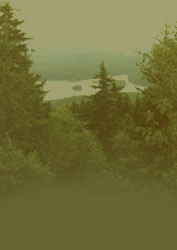|
Do you have something
happening in your corner of Washington? - Please call a member
or e-mail your observations to have them included here
December 2005:
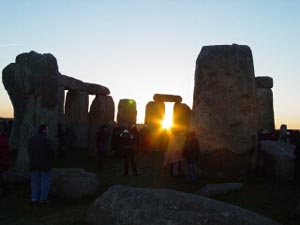
The Winter Solstice, December
21st, marks the beginning of winter in the Northern Hemisphere
and summer in the Southern Hemisphere and It marks the shortest
day and the longest night of the year. The sun appears at
its lowest point in the sky, and its noontime elevation appears
to be the same for several days before and after the solstice.
Hence the origin of the word solstice, which comes from Latin
solstitium, from sol, "sun" and -stitium, "a stoppage."
Following the winter solstice, the
days begin to grow longer and the nights shorter. The Winter
Solstice marks a crucial part of the natural cycle. In a real
sense, the sun begins anew its journey toward longer days,
times of new growth and renewal of the world once again. In
a spiritual sense, it is a reminder that in order for a new
path to begin, the old one must end and that spring will come
again. No one's really sure how long ago humans recognized
the winter solstice and began heralding it as a turning point
-- the day that marks the return of the sun.
November:
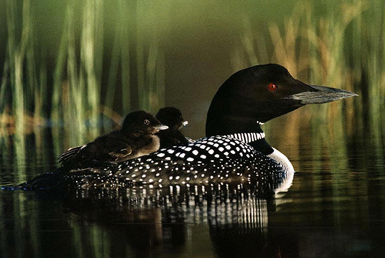
Loons head for the Coast
A warm summer's night on the shore of New Hampshire's larger
lakes wouldn't be the same without the forlorn wail of a loon.
It's hard to imagine these lakes in silence, but they are,
for months at a time, when the loons leave each fall. Our
loons will soon become silent sentinels of the sea, as the
storm-tossed Atlantic will be their home for the winter. Based
on a few bird band returns and radio telemetry studies, we
know that New Hampshire's loons winter along coastal waters
from Maine to the Chesapeake Bay. The Loon Preservation Committee's
preliminary 2005 numbers show that New Hampshire has 203 territorial
pairs of loons and a total of 496 adult loons, about the same
as last year. This year's nesting was affected by wet weather
in late spring and early summer, and the number of loon chicks
hatched (141) and chicks surviving through mid-August (111)
were lower than usual. This time of year, loons fade away
from our lakes along with the disappearing daylight. First
the adults move toward the coast, followed by their young
in a few weeks. Loons are common and easily spotted along
our coast all winter long. Not only are their voices muted
for the winter months, but so, too, is their beautiful summer
plumage. Over the winter, the brilliantly white and olive-colored
birds will become black-and-white silhouettes against the
dark Atlantic waters.
-- Eric Orff, wildlife biologist
Learn more about loons at the Loon Preservation Committee’s website: www.loon.org.
October:
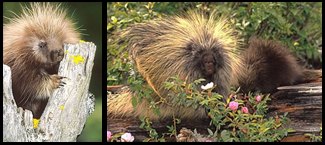
Question: What is a baby porcupine
called?
One animal that won't be vanishing this winter is the porcupine,
which is active year round in New Hampshire. With thousands
of quills on their backs, porcupines are not in any hurry!
They sit quietly munching in trees, or waddle along the ground.
Clues that porcupines are around include ground littered with
short twigs of hemlock. Porcupines break twigs off the larger
branches, chew off the tasty needle tips and toss the rest
away. Chewed bark is another sign. Porcupine scat looks like
a pile of brown elbow macaroni. Porcupines are active mostly
at night. This time of year through early December is their
breeding season. Between next April and August, females will
give birth to one baby. (What's a baby porcupine called? A
porcupette! No kidding!)
Our porcupines are also busy eating up a storm, feasting on
bark, twigs and acorns. Porcupines are best known for defending
themselves with their quills. Quills can be up to three inches
long, and a single porcupine can have 30,000. Porcupines can't
"throw" their quills, but if another animal comes into contact,
the quills release easily. Once embedded, quills work their
way deeper and deeper into an animal's skin (up to an inch
a day!), so they should be removed as soon as possible. Porcupines
don't have quills all over - just on their backs. That's why
they lower their heads and turn their back when threatened.
Coyotes, bobcats, owls and especially fishers prey upon porcupines.
NH Fish and Game
Check out this website about porcupines:
www.nhptv.org/natureworks/porcupine.htm
September:
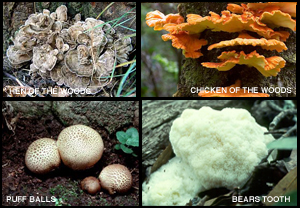
Many mushrooms are fruiting now and Carol
shared pictures she had taken recently of a variety of fungi.
There were Hen of the Woods, Chicken of the Woods, Puff Balls,
Bear's tooth, Berkley's Polypore, Bolete (blue staining),
and another mysterious dark colored, hard fungus that she
couldn't identify. Mark asked if anyone knew of a spring on
the Bradford Road found on the right hand side of the road
as you come into East Washington. He remembered it as a place
where people filled their jugs long ago but he hasn't been
able to locate it now. If anyone knows of the whereabouts
of the spring, let us know.
August:
July was the 2nd hottest in NH history.
Peter took 2 groups on hikes recently on the Williams property
up to Stoddard Rocks. One of the kids found 56 Red Efts and
2 Red Backed Salamanders during the hike. They also surprised
a sleeping moose along the trail, who leapt up and ran, which
was quite a sight. Here is some information on the
Red Eft & Red-Spotted Newt - Notophthalmus
viridescens
The Eastern Newt is unique in that they undergo two metamorphoses.
The first is the usual transformation from aquatic, gilled
larva to an air-breathing terrestrial form. Three or four
months following hatching, the larva loses its gills, develops
lungs, and begins life on land as a Red Eft. Efts usually
reach about 3 inches in size.
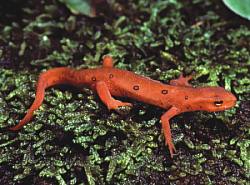
During the next two to three years, it
will forage on the forest floor, often wandering about boldly
during the day, especially during or just after a rain. Although
it is conspicuous during this red eft stage, other animals
seldom bother it because its skin glands produce irritating
secretions and their bright coloration serves as a warning.
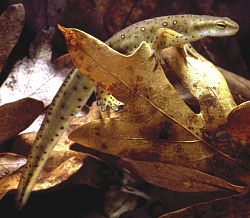
During the third year of its life, a remarkable
transition occurs. The skin becomes slimy and changes from
orange to olive green. The tail becomes broad and wedge-shaped,
and the body looks more like that of a salamander than a lizard.
At this point, the salamander returns to water to breed and
remains there for the rest of its life as a mature red-spotted
newt (pictured right). Adults reach lengths of nearly 5 inches.
Newts occur sporadically throughout our state in permanent
or semi-permanent bodies of water bordered by relatively undisturbed
woodlands.
- Ohio Department of Natural Resources,
Division of Wildlife and USGS Northern Prairie Wildlife Research
Center
Tom was hiking the north slope of Lowell
Mountain and came upon a Goshawk who was nesting nearby. He
said it was like Pearl Harbor, the hawk was swooping and attacking
to protect its nest. Tom also watched a Loon swimming totally
underwater on Millen Pond.
June:
John reports that May 2005 was the 3rd
coldest May in NH history, since they started recording the
weather, and the coldest since 1917. We should expect more
extremes in the weather because of global warming.
We have had lots of rain and mushrooms are
abundant due to the wet weather.
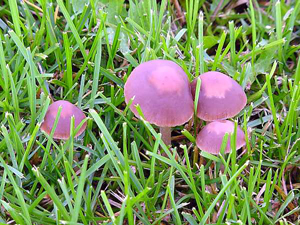
The bears are out looking
for food after rainstorms. There are many blueberries on the
bushes this year, which should please the bears. Carol mentioned
that porcupines are also out after rainstorms
and her poor dog came home with the evidence.
Mark reported watching a pair of deer several
mornings in East Washington.
May:
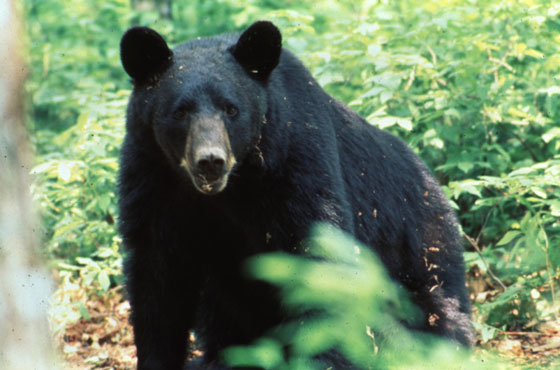
Black Bears
are visiting at Halfmoon Pond. The bears are pretty hungry
this spring. The last couple of years have been very poor
for mast production. Mast is divided into categories of "hard
mast" and "soft mast". "Hard mast"
refers to hard-shelled seeds, such as acorns and hickory nuts.
"Soft mast" describes seeds that are covered with
fleshy fruit, as in apples and berries. Mast may also include
seeds and fruits of all other plants such as grasses, herbs,
pines, hardwoods, and fungi. These provide food for the bears
and other wildlife species.
Learn more about Black Bears:
http://www.wildlife.state.nh.us/Wildlife/Wildlife_profiles/profile_black_bear.htm
For information about living with bears in New Hampshire:
http://www.wildlife.state.nh.us/Wildlife/Somethings_Bruin.htm
Turkeys
are having a good year.
Look for vernal pools in your area, they
are filled with eggs right now.
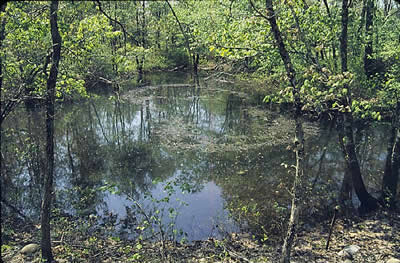
Vernal pools are temporary
bodies of water that flood each year for a few months during
the spring and summer. Vernal, or "spring" pools
fill up with melting snow and early rains, then usually dry
up by mid to late summer. Some relatively deep pools may remain
flooded for a few years but become completely dry in seasons
with very low rainfall. Autumnal pools fill during the fall
with rising groundwater.
Because vernal pools are not permanently flooded, they do
not support fish populations and thus provide safe breeding
sites for several amphibian and invertebrate species, including
wood frogs, spotted salamanders, and fairy shrimp. These species
have evolved life cycles that depend on temporary pools.
Vernal pools vary in size, ranging from several square feet
to several acres. They can be found in a variety of sites,
such as isolated depressions in the woods, kettle holes, and
gravel pits. Many are within larger wetlands, such as oxbows
in river floodplains and pools in forested swamps or scrub-shrub
wetlands. Their common characteristics are the absence of
fish, temporary flooding regime, and the presence of vernal
pool species. Suitable pools must have enough leaf litter
and other debris to provide food sources and cover for the
species that breed in them. - New
Hampshire Audubon Society
For more information about vernal pools and what you might
see there go to: http://www.nhaudubon.org/conservation/vernal.htm
February:
Owls are breeding now
By February, Great Horned Owls may already
have eggs in the nest.
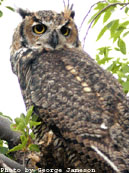
Great Horned Owl Bubo
virginianus
• Length: 20 inches Wingspan: 55 inches,
weight 3-4 pounds,
• Sexes similar, but females are larger
• Very large owl with prominent ear tufts
• Yellow eyes and dark bill
• Upperparts mottled brown, gray, and black
• Pale underparts with fine brown bars
• Reddish-brown facial disks bordered by black with a
lower border of white
• White throat patch
• Pale gray form inhabits northern Canada
Clutch Size:1-4
Length of Incubation: 26-35 days
Days to Fledge:35
Number of Broods:1
Diet: Mostly small Mammals with lesser quantities
of birds and reptiles or amphibians.
Owls, with their huge, luminous eyes and
haunting calls, fascinate humans. New Hampshire's varied habitats
provide year-round homes for several species of owls. New
Hampshire Audubon celebrates March as "Owl Awareness
Month" and invites everyone to join in the thrill
of listening for our owl neighbors.
By February, the Great Horned Owl, our earliest breeding owl,
may already be incubating eggs. You might hear the resonant
bass hoot of this magnificent predator anytime during late
winter. In late February, we started to hear the familiar
"Who cooks for yoou, who cooks for yoou aaal!" of
the Barred Owl, our most common owl. Near dense hemlock and
spruce woods, listen for the mechanical-sounding, single-pitched
beeps of the tiny Saw-Whet Owl. Attentive owlers in southern
New Hampshire might be treated to the mournful, descending
trill of the Eastern Screech Owl.
You can listen to owl sounds at this website:
http://www.owlpages.com/species/bubo/virginianus/Default.htm
Owlers who take to the woods in hopes of a glimpse of these
special birds should remember that the Great Horned Owl is
a vigilant defender of its nest. Swooping down silently, the
Great Horned Owl, with its formidable talons, can spell real
trouble for prey - or an inattentive intruder!
Description: Great Horned Owls can vary in
colour from a reddish brown to a grey or black and white.
The underside is a light grey with dark bars and a white band
of feathers on the upper breast. They have large, staring
yellow-orange eyes, bordered in most races by an orange-buff
facial disc. The name is derived from tufts of feathers that
appear to be "horns" which are sometimes referred
to as "ear tufts" but have nothing to do with hearing
at all. The large feet are feathered to the ends of the toes,
and the immature birds resemble the adults. Females are 10
to 20% larger than males.
Voice: Great Horned Owls have a large repertoire
of sounds, ranging from deep booming hoots to shrill shrieks.
The male's resonant territorial call "hoo-hoo hoooooo
hoo-hoo" can be heard over several miles during a still
night. Both sexes hoot, but males have a lower-pitched voice
than females. They give a growling "krrooo-oo" or
screaming note when attacking intruders. Other sounds include
a "whaaa whaaaaaa-a-a-aarrk" from disturbed birds,
a catlike "MEEE-OWww", barks, hair-raising shrieks,
coos, and beak snapping. Some calls are ventriloquial. Most
calling occurs from dusk to about midnight and then again
just before dawn.
Hunting & Food: Great Horned Owls hunt
by perching on snags and poles and watching for prey, or by
gliding slowly above the ground. From high perches they dive
down to the ground with wings folded, before snatching prey.
Prey are usually killed instantly when grasped by its large
talons. A Great Horned Owl may take prey 2 to 3 times heavier
than itself. They also hunt by walking on the ground to capture
small prey or wading into water to snatch frogs and fish.
They have been known to walk into chicken coops to take domestic
fowl. Rodents and small rabbits can be swallowed whole while
larger prey are carried off and ripped apart at feeding perches
or at the nest. Birds are often plucked first, and legs and
wing tips discarded. An extremely wide range of prey species
(at least 253 identified) are captured, but rabbits and hares
are its preferred prey. Mammalian prey includes all coexisting
rodents, squirrels, mink, skunks, raccoons, armadillos, porcupines,
domestic cats and dogs, shrews, moles, muskrats, and bats.
Bird prey includes all other Owls (except Snowy Owl), grouse,
woodpeckers, crows, turkeys, pigeons, Red-tailed Hawks, bitterns,
Great Blue Heron, ducks, swans, gulls, etc. Reptiles include
snakes, turtles, lizards, and young alligators. Amphibians
include frogs, toads, and salamanders. Other foods include
fish, large insects, scorpions, centipedes, crayfish, worms,
spiders, and road killed animals.
Pellets are very large, about 7.6 to 10.2 cm (3- 4")
long and 3.8 cm (1_") thick. Pellets are dark greyish-black
and compact. Skulls as wide as 3 cm (1.2") are regurgitated
whole. Pellets are regurgitated 6 to 10 hours after eating.
Breeding: Nesting season is in January or
February when the males and females hoot to each other. When
close they bow to each other, with drooped wings. Mutual bill
rubbing and preening also occurs. They do not build a nest
of their own but utilise the nests of other birds such as
the hawk, crow and heron. They may also use squirrel nests,
hollows in trees, rocky caves, clumps of witches broom, abandoned
buildings, or on artificial platforms. They are extremely
aggressive when defending the nest and will continue to attack
until the intruder is killed or driven off. Normally, two
to four eggs are laid and incubated by the female only for
26-35 days. Young start roaming from the nest onto nearby
branches at 6 to 7 weeks, when they are called "branchers",
but cannot fly well until 9 to 10 weeks old. They are fed
for another few weeks as they are slowly weaned. Families
remain loosely associated during summer before young disperse
in the autumn. Adults tend to remain near their breeding areas
year-round while juveniles disperse widely, over 250 km (150
miles) in the autumn. Territories are maintained by the same
pair for as many as 8 consecutive years, however, these Owls
are solitary in nature, only staying with their mate during
the nesting season. Average home ranges in various studies
have been shown to be approximately 2 square kms (1 square
mile).
Mortality: A long-lived Owl, captive birds
have been known to live 29 to 38 years, and wild Owls up to
13 years. Most mortality is related to man - shootings, traps,
road kills and electrocutions. The only natural enemies are
other Great Horned Owls and, occasionally, Northern Goshawks
during disputes over nest sites.
Habitat: Great Horned Owls have adapted to
many different places and climates. They occur in habitats
from dense forests, deserts and plains to city parks. They
have been known to inhabit the same area as the diurnal red-tailed
hawk.
Distribution: Great Horned Owls are found throughout North
America from the northern treeline and then in Central and
South America. They are resident year-round, however, birds
living in the northern part of the species' range may migrate
south.
Owls can’t really turn their heads all the way around.
They can rotate their heads 270 degrees, thanks to extra vertebra
in their necks. Because their eyes are fixed in their sockets
- they can't move their eyes up or down or side to side -
the owl has to move its whole head to compensate for the fixed
eyes.
January 2005:
Snowshoe Hare Lepus americanus
The snowshoe hare is one of New Hampshire's wildlife residents
that is well adapted to winter. Beginning in the fall, as
days get shorter, their color changes from summer brown to
winter white, so they're sometimes called "varying hares."
This white camouflage serves them well when snow covers the
ground, making them less visible to predators. But this white
coat also helps the hare conserve up to 25 percent more of
its warmth. The hare's entire metabolism changes from summer
to fall, so they use fewer calories and require less oxygen
while they're finding food that has less nutritive value.
Summer Coat
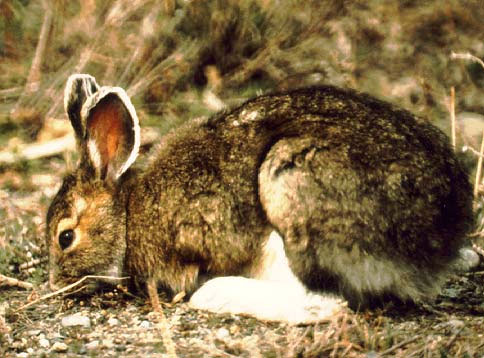
Winter Coat
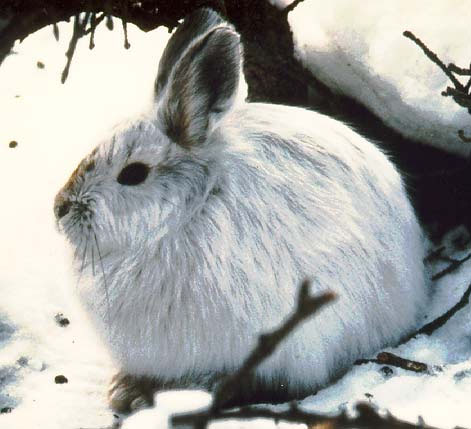
In addition to changing color, snowshoe hares
have large feet adapted for snow travel. These feet actually
allow their bodies to be supported on the surface of the snow,
rather than sinking in. This allows hares to more easily escape
larger predators such as bobcat. Because they don't sink into
the snow, it's easier for them to move during the winter,
which means they use less energy than animals of the same
weight with small feet. Another bonus: with each snowfall,
hares can reach a new layer of twigs to feed on.
Most active at dusk and before dawn, snowshoe
hares leave behind large, triangle-shaped tracks. Where they
are very active, the place may even appear to be packed down.
Hares are found in places with dense cover; their favored
foods include birches, willows and aspens. During the day,
they rest in what are called "forms" -- hollowed-out areas
on the ground with some cover overhead. They feed at night,
with peak feeding occurring around 11:00 p.m. While foraging,
the animals often follow paths or “runways” which are worn
into the vegetation. These runways can be quite obvious in
areas of high hare densities. Another sign of the presence
of snowshoes is a dust bath, where small groups of hares may
gather to groom. Snowshoe hares rarely leave wooded areas.
The snowshoe hare's main defense is sitting still, relying
on its camouflage to keep it hidden. However, if danger gets
too close, they escape using other skills: speed, leaping
ability and knowledge of the trails in their home range. So,
when you're out and about this winter, look closely in areas
of dense cover to see if you can find evidence of the highly
adapted snowshoe hare.
Hares are not highly social. During the breeding
season, pregnant females drive off intruding males and male
hares may actually fight each other by biting and clawing.
The home range of female snowshoes average three to four acres,
while males travel greater distances, covering the home areas
of several females.
Snowshoes have up to three litters in a year,
with three to four young per litter. A young hare is called
a leveret.
Snowshoes are relatively small animals; about
midway in size between cottontail rabbits and jackrabbits.
Adults measure 15-20 inches in length and weigh 2-4 pounds.
Male hares usually weigh about 10 percent more than females.
Snowshoe hares represent important food for
bobcats and are preyed on by a large number of animals, including
coyotes, foxes, weasels, great horned owls, and some of the
larger hawks.
Track pattern
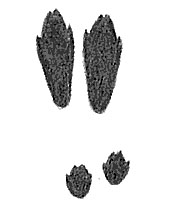
Track: Hindprints are 4-5"
(100-125 mm) long (longer in snow) and wider in front than
cottontail's; foreprints smaller and rounder, and placed behind
paired hindprints when running, producing a distinctive set
of 4 tracks.
Sign: Leaves network of trails
in snow (packed down as much as 1'/300 mm deep) and tufts
of soft fur snagged on low branches. Clipped shoots are cleanly
cut on a slant; deer's are ragged at tip. Scat: Brown, slightly
flattened spherical pellets, similar to those of Eastern Cottontail
but larger.
Scat 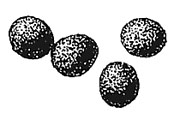
Most of this copy comes from NH Fish
and Game, written by Judy Silverberg, Wildlife Educator
To view yearly archives of our "New In
Nature" series click on year you wish to see.
2002
2003
2004
2005
2006
2007
2008
2009
2010
2011
2012
|


